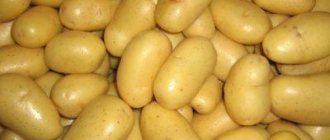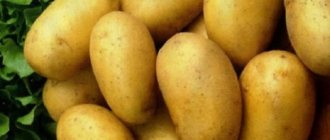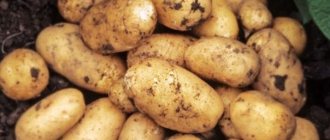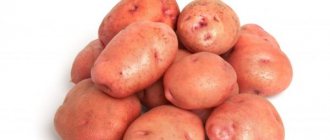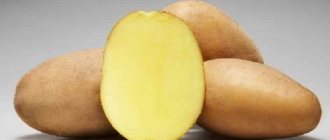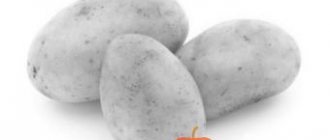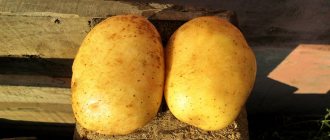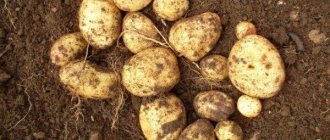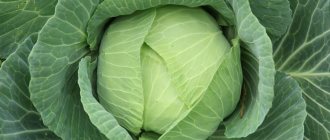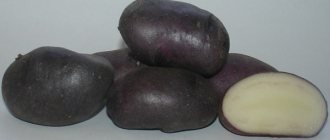Agricultural technology
The agricultural technology for growing Lilly potatoes is similar to other varieties. However, there are some peculiarities. For example, a potato plot needs timely watering. It is necessary to moisten the soil periodically throughout the growing season and especially during flowering. This can be done once a week or more often. The water should not be cold. The most optimal time for watering is evening or morning hours.
Potatoes before planting
Another feature of the variety is that it loves space. The distance between plants should be large - from 60 cm. Otherwise, many small tubers will grow on the bushes.
Lilly seed potatoes can be cut into pieces before planting. It is best to dry the particles a little.
The site is prepared in advance. The best predecessors for the crop are cucumbers, beets, carrots, and cabbage. Potatoes love loamy, light soil. If the soil is acidic, it must be deacidified. The site is fertilized with organic matter and dug well. In the spring, fertilizers containing nitrogen, phosphorus, and potassium are added there.
Planting takes place in May, when the soil warms up to 10 degrees. The depth of the holes is about 10 cm. It is important that the depth for all tubers is the same and the rows are even. A handful of ash, a little humus, and complex fertilizer are added to the holes along with the potatoes. The potatoes should be positioned so that the sprout is at the bottom.
Lilly, like Lola potatoes and other similar varieties, is easy to care for. It needs to be hilled up, weeded, and prevented from the Colorado potato beetle.
Growing rules
It is believed that growing potatoes can be done on any type of soil, but it is best to choose light, loose soil with sufficient nutrients, since this variety of vegetable really needs regular fertilizers.
Increasing the fertility of the soil is quite simple, you just need to carefully dig up the area and add at least humus or compost, then again loosen the soil too deeply.
Before planting, potatoes are first checked for rot or other damage and are selected if the crop has not been sorted after digging.
Afterwards, the tubers are taken out into the sun so that they warm up, dry out better and sprout.
Shallow holes are made along the entire perimeter of the prepared area, where ash is poured and, if desired, a little humus. When digging holes, maintain an interval of 35 cm between bushes and 70-80 cm in rows, so that it is convenient for plants to grow and develop, and for people to provide the necessary care.
Afterwards, potatoes are placed in the holes with their sprouts up and buried with earth. The first shoots are expected in 10-14 days.
Proper care of potato bushes
The Lileya potato variety was created by Belarusian breeders more than 10 years ago. In Russia, this variety of vegetable began to be grown not so long ago, but it had a great influence on summer residents and gardeners, and currently grows widely in various regions of our country.
As for yield, the description of the lily potato speaks of its abundance. And this is the real truth, this variety has good productive qualities, which increase significantly with proper plant care and proper planting.
According to statistics, the maximum volume of potato harvest was about 75 t/ha, and on average you can get 400 t/ha. Therefore, the vegetable is widely used not only for personal consumption, but also for sale.
Interesting! From one potato bush you can dig up to 20 medium-sized tubers. There are almost no small details in the total amount of harvest.
The reasons for the popularity of Lily potatoes are explained by positive reviews from gardeners and the following characteristics:
- Good marketability and keeping quality of the vegetable.
- Potatoes are suitable for long-term storage.
- It is resistant to mechanical stress.
- High yield.
- The plant is easy to care for and grow, and does not depend on the type of soil.
- It has excellent taste.
- Tubers ripen in about 80-90 days.
Note! The starch content in potatoes ranges from 12 to 17%, which allows the vegetable to be used for preparing potato starch, medicines and other products.
The love of Belarusians for potatoes has already become a kind of stereotype, at the same time, this wonderful variety comes from Belarus. What is the value of this variety?
Potatoes "Lileya" are an early table variety; their ripening time is 60-75 days from the date of first shoots. Forms strong, semi-spreading bushes with medium-sized leaves and dark green color. The inflorescences form a small white corolla.
The average weight of one tuber is from 100 to 200 g. The skin of the tubers is yellow, smooth. The potato pulp is creamy white, its starch content reaches 17%. In terms of their table purpose, the tubers are universal, as they are perfect for frying, boiling, stewing, baking and making purees.
The key to successful cultivation of the Lileya variety is compliance with certain stages of agricultural technology: correct selection and preparation of the site for planting, processing of seed material, planting in the ground and care until harvesting.
First of all, when choosing a site for potatoes, it is necessary to follow the principles of crop rotation - the correct change of crops in one area, which allows you to preserve the beneficial qualities of the soil, as well as effectively combat diseases that cannot take root in one area if vegetable crops are constantly changing.
Potatoes should not be planted in the same area for several years in a row. Other representatives of nightshades are also not suitable as predecessors to potatoes: tomatoes and eggplants. Potatoes grow poorly after pepper. At the same time, good predecessors for potatoes are green manure herbs, root vegetables, cucumbers, cabbage, and legumes.
It is necessary to bring humus to the site in the fall, distributing it evenly over the ground. Before the beginning of winter, deep plowing of the soil is carried out, thanks to which the soil is mixed with the added organic matter, and the furrows formed allow the upper layers of the soil to freeze enough to destroy pests and pathogens.
Instead of organic matter, you can apply mineral fertilizers that contain phosphorus and potassium. Mineral fertilizers are applied in dry form, because they will dissolve in the soil during the fall and winter.
You may be interested in:
Important! You should be more moderate with nitrogen-containing fertilizers, as they promote the development of tops to the detriment of yield.
It is better to select seed material for planting when harvesting the current season, placing some of the most attractive tubers separately in a box. Such potatoes should be stored in a cool and dark room and if sprouts appear, tear them off so that the tubers do not lose strength and do not wither.
20 days before planting, the tubers begin to be prepared for planting. First of all, potatoes are germinated - vernalization. To do this, the tubers are placed in a warm and well-lit room, evenly spread on the floor or in shallow boxes. Thanks to vernalization, tubers awaken from hibernation, warm up and form sprouts for future shoots.
Important! Vernalization in polyethylene can significantly speed up the process of sprout formation: the potatoes are laid out in bags with holes made for ventilation. The greenhouse effect of polyethylene allows potatoes to germinate in 5-7 days.
Immediately before planting, it is advisable to treat the potatoes with fungicides and insecticides so that the bushes do not initially become sick and are not affected by insect pests. The drugs Prestige, Poteytin, Epin-Extra, Immunocytofit and others are excellent for these purposes.
Potatoes are planted when the soil warms up to at least 10ºC. As a rule, in the climatic conditions of Russia, these conditions are achieved in the second half of April - the first half of May.
Interesting! According to folk wisdom, potatoes can be planted when the bird cherry blossoms.
Before planting potatoes, the area must be loosened. To break up piles of earth formed after deep plowing, it is recommended to use milling.
Potatoes are planted according to a pattern of 50 cm between rows and 35 cm between bushes in a row. In case of planting under a shovel, the holes are dug in a checkerboard pattern. When planting, potatoes are placed in the furrows in a checkerboard pattern. Each hole should be fertilized with a small amount of cow manure or bird droppings.
You can add a glass of ash to acidic soils. Instead of organic matter, mineral fertilizers containing phosphorus and potassium are used. To do this, pour 1 teaspoon of dry fertilizer into each hole. After planting and fertilizing, the holes are dug in, and the soil is carefully distributed on the surface with a metal rake.
The first shoots appear after two weeks. After their appearance, be sure to carry out the first weeding. During the entire growing season, potatoes must be hilled at least 2 times, forming high ridges of soil up to 20 cm.
Important! It is better not to bring the sides of the beds together, forming a sharp end, but to leave a gap of 5 cm between them, which forms a groove for collecting rainwater.
For watering, it is recommended to install a drip irrigation system that evenly saturates the soil.
During growth, potatoes of the Liley variety need to be additionally fertilized at least 2-3 times with superphosphates and potassium nitrate.
Diseases and pests
Lileya potatoes are quite resistant to potato viral diseases, potato cancer, golden potato nematode, late blight and fusarium. Potatoes are susceptible to damage from the Colorado potato beetle, mole cricket, wireworm, and aphid, therefore, for preventive purposes, the bushes are treated with insecticides.
Thus, the “Lileya” variety is an excellent example of an ideal potato, suitable for cultivation both on a personal plot and on an industrial scale.
In the modern world, there are many varieties of potatoes, but not all of them are characterized by early ripening and ease of care. Belarusian breeders tried to take into account the most important characteristics of the vegetable crop and in 2007 they developed a new variety of root crop, and in 2008 it was entered into the state register.
Important! Potatoes of the Lileya variety are resistant to climate change, have natural immunity to viral and fungal diseases, and the ripening time of the crop is a little more than 2 months.
Through the efforts of Belarusian breeders, the best qualities and characteristics of the vegetable crop were collected in the Lileya variety.
Medium-sized bushes with branched stems. The foliage on the bushes is dense, dark green in color. During the growing season, multiple inflorescences appear, which bloom with small, white flowers.
With proper and timely care, one potato bush produces up to 15 large root crops. In industrial quantities, up to 70 tons of vegetables are harvested from 1 hectare. The weight of each vegetable is from 100 to 200 g, the skin is light and smooth. Tubers contain a large amount of vitamins and other useful substances. The pulp of the root vegetables is white, with a slight creamy tint.
Where are the fruits used?
The high taste characteristics of Lileya potatoes are widely used in cooking. Vegetables are suitable for any heat treatment. Potatoes are boiled, fried, stewed, baked and frozen. In the food industry, this variety is used for the production of various semi-finished products and baby food.
Lileya potatoes do not require special care, but some rules of agricultural work must be followed. As soon as the first shoots appear, the beds are cleared of weeds.
Regularity of watering
Until the first shoots appear, the plant does not need watering. After the potatoes have begun active growth, the watering schedule is set as needed. As soon as the soil becomes dry and cracked, the plants need to be watered.
Important! The crop requires additional moisture during the period of bud formation and flowering.
Insufficient moisture during the growing season will affect the quality and quantity of the harvest.
Timely feeding and fertilizing of potatoes allows you to get healthy plants and a bountiful harvest of root crops. The first time the crop is fertilized during planting with organic or mineral fertilizers. Next, fertilizers containing phosphates are used, they promote the development and ripening of root crops.
During the period of active growth of bushes and formation of inflorescences, potatoes are fertilized with root fertilizers. The vegetable crop responds well to additional nutrition, and the result is reflected in the yield.
The first loosening of the soil is carried out immediately after planting vegetables. Thorough loosening helps enrich the soil with oxygen, gets rid of unwanted weeds and insects, and also helps retain moisture. The loosening process must be repeated as soon as a hard crust of soil forms on the potato beds.
Features of care
After planting and until germination, regular loosening is carried out; this will help loosen trampled areas and also provide oxygen access to the tubers. Loosening is carried out using a rake or diagonally so as not to pull out the planted potatoes.
After the emergence of seedlings, hilling is carried out at least 2-3 times. The first time the procedure is performed after the bushes reach 10-12 cm. Potato plantings are re-hilled after 10-14 days. Thanks to hilling, the growth of underground shoots and the formation of tubers is stimulated.
Watering
Excess moisture prevents the root system from growing deeper. Therefore, do not water root crops immediately after planting. It is carried out after emergence, as needed. Moisture is needed for the growth and formation of bushes, and subsequently root crops.
Bushes need the most liquid during budding. With infrequent watering and lack of moisture, there is a high probability of a decrease in yield. It is best to water with settled water at room temperature. The procedure is carried out early in the morning or in the evening.
Fertilizer application
Foliar feeding is carried out at intervals of 2 times a month. To increase the yield and speed up the ripening of tubers, it is enough to spray the bushes with a superphosphate solution. You can use growth stimulants, however, when using them, additional nutrition is required.
Root feeding is carried out 3 times per season:
- the first time - at the beginning of leaf formation;
- the second time – the period of budding;
- the third feeding - after 2-3 weeks for faster formation of root crops and the root system as a whole.
On a note!
Excess fertilizers can also harm the growth of plants, especially those containing nitrogen. The bushes may begin to grow actively, but the tubers will not grow.
Diseases and pests
The main enemy when growing potatoes is the Colorado potato beetle. Without the use of insecticides, it is difficult to effectively control insects. The first spraying is performed when larvae appear on the leaves. The treatment is carried out on a sunny, windless day. After the procedure there should be no rain for 5-6 hours.
May be interesting Potatoes are super productive and super tasty - the “Golubizna” variety Technology for growing potatoes and caring for them in a barrel Crohn’s potatoes: a rich harvest is guaranteed
Another common pest is wireworm. It affects tubers, which subsequently leads to rotting and the development of many diseases. Before planting, preventive spraying is carried out, and a little wood ash is added to each hole.
The Lileya potato variety is characterized by increased resistance to damage by many diseases:
- golden cyst nematode;
- cancer;
- aucuba mosaic;
- bacterial rot.
Preventive measures help reduce the likelihood of damage. This includes treatment with disinfectants and fungicides, disposal of old stems from plots the previous fall, and the use of insecticides at the slightest sign of disease or pest damage.
Advantages and disadvantages
The peculiarity of the Liley variety is that it has no disadvantages. According to reviews from gardeners and summer residents, potatoes can grow in any territory of Belarus, Russia, and Ukraine. It is unpretentious in the choice of soil and is resistant to temperature changes.
In addition, the variety is endowed with the following advantages:
- early ripeness;
- high productivity;
- good commercial quality of fruits;
- long-distance transportation;
- versatility;
- unpretentiousness in agricultural technology;
- long storage.
In addition, the variety is immune to potato diseases and pests.
- High yield. In this way, Lilly resembles varieties of German selection: Queen Anna, Figaro, Masai;
- Tubers do not darken for a long time after washing and cleaning. A similar property is found in the varieties Nevsky, Laperla, Lilia;
- Like Liley potatoes, it is immune to common diseases: rhizoctonia, hollowness, late blight, scab, and alternaria. Resistant to tuber rot, rust, etc.;
- The variety requires a minimum amount of fertilizer;
- Universal application. Can be used for baby and diet food;
- The Lilly variety can be stored for a long time without loss of presentation and taste. In this way it resembles the Gala variety.
The main advantages of Liley potatoes are:
- Plant resistance to arid climates.
- Rich harvest and high number of tubers in one bush.
- Excellent product properties.
- The vegetable is suitable for long-term storage and sale.
- Potatoes are resistant to dangerous diseases and pests.
- The plant is easy to care for.
- The potatoes are neat, smooth, regular in shape and have excellent taste.
- When cooked, the tubers do not become overcooked due to their high starch content. Therefore, the vegetable is used for any dishes.
Lily potatoes have no disadvantages as such. But gardeners and summer residents highlight the negative qualities of the plant - this is the high demands of tubers on the presence of nutrients in the soil.
Diseases and pests
The Lileya potato variety is immune to:
- To the golden cyst nematode;
- To bacterial rot;
- To potato cancer;
- To the aucuba mosaic.
To prevent the development of common scab and protect against insect pests, follow the following preventive measures:
- Carrying out pre-planting treatment of seed material using special disinfectants;
- During the growth period, spray potato plantings at least three times using insecticidal preparations;
- Infected plants should be promptly disposed of from the site.
Advantages and disadvantages of the Lileya variety
Lilly potatoes are a mid-early table variety. Grown in most regions of the Russian Federation.
The variety was created by breeders of the German company Solana. In 2021, Lilly potatoes were included in the state register of breeding achievements.
The tubers contain the following beneficial substances:
- folic acid;
- organic acids;
- phosphorus;
- iron;
- calcium;
- vitamins B, H, PP, D;
- potassium;
- cellulose;
- ascorbic acid;
- iodine.
The nutritional value of Lilly potatoes is 76 kcal per 100 g.
The variety is suitable for baby food, for people with diabetes, people with metabolic disorders and those suffering from diseases of the digestive system.
Tubers are medium sized, uniform. They are convenient to clean, wash, and pack. The weight of one tuber is 100-150 g. The shape is most often round, sometimes oval. The peel is dense and elastic. The eyes are shallow.
Potatoes have excellent taste: they are buttery, crumbly, moderately sweet, and do not disintegrate or change color during cooking. The average starch content is about 12%.
The yield is high: about 60-80 tons of potatoes are harvested from 1 hectare. The important thing is that to obtain such a high yield, a minimum amount of fertilizer is sufficient.
High yield is also evidenced by a high level of shelf life: potatoes can be stored for up to 9 months without losing their properties.
Officially, the Lilly variety is recommended for planting in the following macroregions of Russia:
- Far Eastern;
- Northwestern;
- Middle Volga.
Lilly is distinguished from most other potato varieties by its high yield, frost resistance, and waste-free use of tubers, which is possible due to their uniformity.
Lileya potatoes are a Belarusian variety. It also belongs to the category of yellow varieties, but it is an early crop, which is somewhat inferior to Lilly in terms of yield. In addition, Lilly is more resistant to common potato diseases.
The advantages of the variety include:
- high productivity;
- tubers do not change color for a long time after washing and cleaning;
- has immunity to common potato diseases: hollowness, rhizoctonia, scab, late blight, alternaria;
- resistant to rot and rust;
- does not require large amounts of fertilizer;
- universal: suitable for baby and diet food;
- can be stored for a long time without loss of taste and presentation.
Disadvantages of the variety:
- high price;
- demanding on watering;
- Certain rules must be followed when planting.
Below are reviews from experienced gardeners about Lilly potatoes.
Georgy, Pskov: “I learned about this variety of potato from my neighbors. The price confused me at first - it was expensive, but I decided to buy it anyway. I didn’t regret it - I like potatoes: they’re tasty and don’t get soggy. And digging it up is a pleasure, because on each bush there are at least 10 large potatoes, small tubers are practically never found. Now I recommend Lilly’s potatoes to everyone.”
Maria, Tula: “Two years ago we planted Lilly potatoes for the first time to test, several rows. We didn’t take into account that we needed to make a large distance between the rows and when harvesting we were disappointed - we came across small tubers, and the seller told us that like these potatoes only grow large. Then I read on the Internet how to plant it correctly.
Konstantin, Yoshkar-Ola: “A neighbor at the dacha recommended the Lilly variety, I had never heard of this before. I decided to buy it. As an experienced gardener, I know that each variety requires its own approach. I immediately learned from the seller how to properly plant and care for it. I fertilized the potatoes with manure according to the scheme, treated them against beetles, and watered them regularly. As a result, I harvested delicious yellow potatoes in the fall. I was very pleased."
The Lileya variety is noted for the following positive properties, which are considered its advantages:
- early ripening, which, under certain conditions, will make it possible to harvest two harvests in a year;
- super-yielding;
- perfectly stored;
- transportable;
- large commercial tubers;
- excellent taste;
- universal, suitable for any dishes;
- unpretentious, resistant to diseases and adverse conditions.
No significant deficiencies of the variety have been identified, but it is demanding in terms of soil nutrition and fertilizing.
general description
The variety has the full official name “Lileya Belorusskaya”. The originator of this variety is the Republican Unitary Enterprise “Institute of Potato Growing of the National Academy of Sciences of Belarus”. The patent was received in 2007. Since 2008 it has been included in the state register of Russia. Designed for cultivation in the Volga-Vyatka, Central, North-Western regions. Used for cultivation on farms, industrial fields and private farmsteads.
Lileya potatoes are varieties with an early ripening period. It takes about 70 days until maturity after emergence. Under each bush, from 8 to 15 potatoes are formed. On average, the yield is 400-700 centners per hectare.
Potato bushes of the Liley variety have a spreading appearance and are highly branched. The stems are semi-vertical. They produce many small dark green leaves. When flowering, 2-3 fork-shaped inflorescences are formed on each bush. The flowers are white.
With proper care, up to 15 potatoes are formed under each bush. They have a regular round shape and are approximately the same size. The surface is smooth, the peel is yellow, the eyes are shallowly set. The average weight of the tubers is 100-200 g. When cut, the flesh is yellow. Starch content – up to 14%.
The Liley variety has table purposes (culinary types A and B). In fact, root vegetables have a universal purpose. It is used for:
- cooking;
- frying;
- baking;
- production of chips, French fries;
- industrial processing;
- production of vegetable mixtures.
During heat treatment, the tubers do not become overcooked and remain a pleasant yellow hue.
Potato Liley: yield, origin, reasons for popularity
Despite its recent appearance, the variety has already earned popularity among agronomists, gardeners and consumers. The reason for this is the presence of those qualities that are required by each category of fans of this variety. Agronomists, farmers and industrialists value it, first of all, for its productivity, unpretentiousness, ability to store and transport, resistance to diseases and adverse conditions. Gardeners and potato consumers value it for its excellent taste and versatility in the use of tubers.
Reviews about the variety
Despite the short period of existence, the Lileya potato has become popular among vegetable growers and consumers. Due to its productivity, undemandingness, excellent keeping quality, transportability, good immunity and resistance to adverse weather conditions, the Lileya variety was appreciated by farmers and industrialists.
Potatoes "Lileya" are high-yielding varieties and have good taste and commercial qualities. Due to its ease of cultivation, unpretentiousness to care and weather conditions, it is successfully cultivated by private gardeners, farmers, industrial and agricultural producers. Tubers are tasty, healthy, nutritious and versatile in use.
Lileya potatoes are a product of Belarusian selection. The variety is popular among ordinary gardeners and farmers. Large oval tubers are suitable for both home use and sale.
Description and characteristics of Liley potatoes
Diseases and pests
The technique for growing the Lilly variety is similar to other varieties, but there are still some nuances.
Potatoes can be cut into pieces; it is advisable to dry them immediately before planting.
The site is prepared in advance. For Lilly, light loamy soil is preferred. It is advisable to plant in an area where beets, cucumbers, cabbage, and carrots previously grew. Acidic soil - deoxidize, fertilize with organic matter, dig up. In the spring, fertilizers containing phosphorus, potassium, and nitrogen are applied.
It is recommended to plant potatoes in May; the soil should warm up to 10°C. Holes are dug at least 10 cm deep.
Plant the tubers with the sprout facing down. Plants should be located at a large distance from each other (at least 60 cm), otherwise the tubers will be small.
It is advisable to arrange potato rows from north to south: with this arrangement, the potatoes will receive enough sunlight both in the morning and in the evening.
The Lilly variety is unpretentious to care. Standard measures are required: weeding, hilling, prevention of the Colorado potato beetle.
Nuances of care
The main feature of caring for Lilly potatoes is abundant and timely watering.
The key to a large harvest is the correct selection of planting material. Therefore, you first need to sort through all the tubers. You can use leftovers from last year, but to do this they must be carefully inspected. Small and medium potatoes will do.
Planting material must be cleaned of dirt, dried and germinated. To do this, put the potatoes in a bag, make a few holes in it and leave it for three weeks.
Soil preparation
The variety is sensitive to soil, so its preparation must be approached thoroughly. The soil should be nutritious and light. To do this, it is loosened and dug up in the fall. Additionally, humus is added to it.
In spring, the soil is dug up again and organic fertilizers are added.
Planting process
Places for planting are made at a distance of 30 cm from each other, with 70 cm between rows. Large potatoes are planted at a depth of 9 cm, small ones - 6 cm. When planting, it is necessary to maintain all distances, since if the potatoes grow in a heap, there will be no harvest or the tubers will grow very small.
The variety can be planted in the ground after cabbage, legumes, herbs and cucumbers. Do not plant in soil where sunflowers or tomatoes previously grew.
To create comfortable conditions for the variety, it will be enough to follow simple agrotechnical work.
Plant care includes:
- Watering. Irrigation is carried out as the soil becomes dry. The best option for irrigation is the drip method. Using this method, all bushes will evenly receive the required amount of water.
- Weeding. Timely removal of weeds and loosening of the soil will contribute to the quality development of the root system.
- Hilling. Rolling the soil to the lower parts of the plant increases the space for the development and growth of tubers. This manipulation is carried out at least 2 times during the entire period of growing potatoes.
- Feeding. For intensive plant growth, complex fertilizers are used. They are introduced in liquid form, having previously been combined with droppings.
By following these rules of care, it will be possible to increase the merits of the variety.
Lileya potatoes are suitable for growing in regions with different climatic conditions. In the southern regions, the vegetable is planted in open ground at the end of April, in the central regions at the beginning of May, and in the northern latitudes, planting work begins based on weather conditions. As soon as the soil warms up to 6-8 degrees, the crop can be planted in open ground.
Important! The variety is early ripening, so it is primarily suitable for regions with an unstable climate and frequent changes in summer temperatures.
Tuber preparation
Properly selected planting material is the main step to obtain a good harvest. If root crops from previous harvests are used for planting, then small and medium-sized vegetables are selected.
Tubers for planting in open ground are prepared in advance:
- Planting material is carefully inspected for damage and rot.
- Tubers must be cleaned of dirt and dried before planting.
- Next, the tubers are germinated. This procedure requires from 15 to 25 days, which must be taken into account when calculating the timing of planting the crop.
- Before planting, root crops are disinfected with a manganese solution or special preparations.
Interesting! In order for the tubers to germinate faster, they are covered with a film with small holes or put in bags. This greenhouse effect allows vegetables to germinate within a week.
Preparing the site for planting potatoes begins in the fall. The soil is carefully dug up and mixed with humus. Ash is added to highly acidic soil.
In the spring, the beds are dug up again and mixed with organic or mineral fertilizers.
A major role in the development and ripening of potatoes is played by its predecessors planted in open ground. The culture will do well in soils where cucumbers, herbs, cabbage or legumes grew. It is not recommended to plant potatoes after tomatoes, sunflowers and any crops of the nightshade family.
In the prepared area, holes are dug at a distance of 30-35 cm from each other. A distance of 60 to 75 cm is maintained between the beds. Large tubers are buried 8-10 cm from the soil surface, small planting material - 5-7 cm. Potatoes can also be planted in common trenches, maintaining the required distance between root crops. After planting, the beds are watered with settled, warm water.
Regularity of watering
Correct fit
Basic rules for planting the Lileya variety:
- Maintain crop rotation. Correctly changing plants on a site helps preserve the beneficial properties of the soil, and is also effective in combating diseases that are unable to take root in one site, since crops are constantly changing;
- Plant after green manure grasses, root vegetables, cucumbers, cabbage, and legumes. Do not plant after tomatoes, eggplants and peppers;
- In autumn, humus is distributed on the site. Afterwards, the soil is deeply plowed, while simultaneously mixing with organic fertilizer. You can replace organic fertilizers with mineral fertilizers with phosphorus and potassium;
- Three weeks before planting, seed material is prepared. Seed material is germinated in a warm and well-lit room. To speed up the process of sprout formation, seed material is placed in plastic bags with holes for ventilation. Thanks to the greenhouse effect, the tubers will germinate in 5-7 days;
- Pre-planting treatment of planting tubers is carried out with fungicides and insecticides to prevent the occurrence of diseases and damage by insect pests;
- Plant seed material in soil heated to +10 ºС;
- The distance between holes is maintained at 35 cm, row spacing is at least 50 cm;
- Manure or bird droppings are added to the planting holes. Add a glass of wood ash to the acidic soil. You can replace organic fertilizer with mineral fertilizers containing phosphorus and potassium (one teaspoon of dry fertilizer per hole);
- After the hole, you need to dig in and carefully level the soil using a rake.
How to care for plantings:
- 14 days after planting, weed for the first time;
- During the season, potatoes are hilled twice to form ridges up to 20 cm high;
- To evenly saturate the soil, use a drip irrigation system;
- During the growing season, superphosphate and potassium nitrate fertilizers are applied two to three times.
Potato Liley: yield, origin, reasons for popularity
As soon as the bushes of the plant begin to dry out and wither, the root crops are ready for harvesting. The tops are cut 5-7 days before the start of harvest. Dig up potatoes with a pitchfork, this way there is less chance of damaging them. After the root crops are dug up and cleared of excess soil, they are dried in the sun and planting material is selected for the next planting work.
During the storage period, root crops are sorted and sorted. Strong and healthy potatoes are sent for further storage, rotten and spoiled ones are thrown away, and the rest are eaten. With the right approach and conditions, potatoes can easily be preserved until spring.
The moment of ripening is easy to see - the bushes begin to wither. After this, you can start collecting potatoes. Before starting the process, it is better to cut off the vegetation and this should be done a week in advance.
You need to dig up the tubers with a pitchfork, as a shovel can damage them. The tubers are cleaned, dried and sorted. Some of the material is put aside for next year.
Potatoes are stored well in wooden boxes in the cellar
Once every two to three months, the collected tubers are checked and the rotten ones are thrown away. If properly organized, they are stored until May.
You can estimate the harvest period yourself. To do this, you need to carefully monitor the tops of the plant. If green foliage is observed on the potatoes, it means that the process of growth and development of the tubers has not yet ended. Therefore, it is too early to harvest. As soon as the tops acquire a yellowish tint and begin to dry out, you can safely begin digging potatoes. To facilitate this process, it is recommended to completely cut off the stems and leaves approximately 2-3 days before harvesting.
After the potatoes are dug, their tubers must be dried. To do this, they are laid out on plastic wrap and left in the sun for about 3–4 hours. After this, the potatoes are cleared of soil and sorted into food, small items and planting material. Then the harvest is put into bags and taken for storage.
The Lileya potato variety is stored exclusively in the cellar, at a temperature of 2–3 degrees above zero. In this case, the underground room must have a ventilation hood. For ease of storage, wooden boxes and mesh bags are used. Such recommendations are due to the fact that the bulb should be removed from rot once every 3 months.
Having considered the above characteristics, advantages and features of the Lileya variety, you can independently verify its uniqueness. Having planted this crop, either in agricultural enterprises or in small gardens, every fruit and vegetable grower will be satisfied with the quality of its products.
Harvesting Lilly potatoes is similar to other potato varieties.
Potatoes are dug 50-60 days after they are planted in the soil. The growing season may vary slightly depending on the weather conditions of the region.
The readiness of the fruit for harvesting is determined by the change in color of the tops - it should turn yellow. To facilitate the process of digging potatoes, the tops should be cut off 2-3 days before harvesting.
It is recommended to dry the dug up potatoes. To do this, the tubers intended for food are poured onto the floor in a well-ventilated area. The potato layer should be no more than 20 centimeters. It is important that the floor is not concrete, preferably wooden. Dry the potatoes for at least 10 days, turning the tubers periodically. Seed potatoes can be dried in the sun.
Lilly has a high shelf life. In favorable conditions, potatoes can be stored for 9 months without losing their quality.
Advantages and disadvantages
The positive characteristics of the variety include high productivity and adaptability to different weather conditions. It is low maintenance and therefore suitable for beginning farmers. Another advantage of the variety is its low susceptibility to fungal diseases, nematodes and cancer.
A high-quality Liley variety, potatoes have high characteristics. Experienced agronomists highlight only one negative quality - it is demanding on the composition of the soil.
It is also important to understand that resistance to diseases does not mean that the variety is completely protected from them. Therefore, it is necessary to carefully monitor the condition of the plantings and carry out preventive measures.
The benefits of Lilly potatoes
Lilly potatoes contain a lot of useful substances:
- potassium;
- iron;
- phosphorus;
- cellulose;
- iodine;
- folic acid.
In addition, the tubers contain vitamins B, PP, H, and C in sufficient quantities.
100 g of product contains 76 kcal.
Due to the low sugar content, these potatoes can be used for preparing children's and dietary dishes. It is also suitable for people who have problems with the gastrointestinal tract, diabetes and metabolic disorders in the body.
